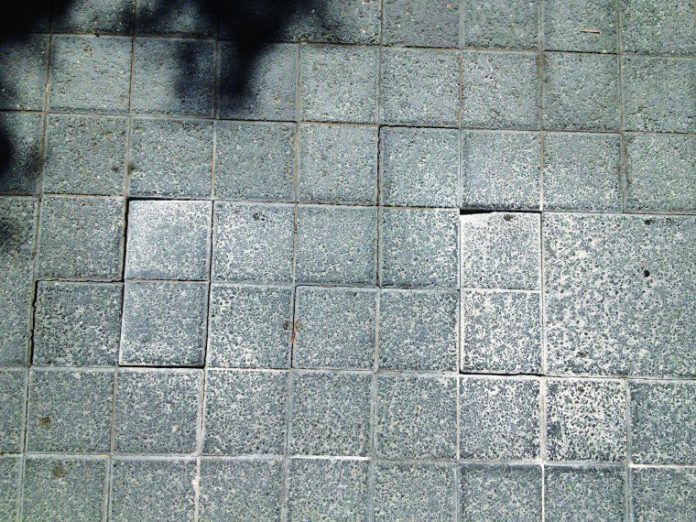
Morgan Hill’s Third Street Promenade, built in 2009 as a focal point and entertainment center for downtown visitors, will continue to sink, rattle and crack until three parties involved in its construction come to terms on who is responsible for repairing the flaws that are causing the chronic damages.
Whether those flaws lie in the unusual street project’s design, construction or other factors remains to be determined after City Hall, construction contractor Jos. A. Albanese, Inc., and design contractor BKF Engineers sit down for a dispute mediation later this month.
The mediation will be conducted by James Castles of the Robles, Castles and Meredith LLP law firm in San Francisco, according to Morgan Hill City Engineer Karl Bjarke.
“We’ve been taking the approach the contractor needs to come in and make those repairs,” Bjarke said. “Until we learn differently, we think it’s a construction warranty issue.”
Built in 2009 at a cost of about $3.6 million (mostly financed by the city’s former Redevelopment Agency and a state grant) the Third Street Promenade was designed to be aesthetically inviting, with decorative bollards, landscaping and a water feature. Toward the west end of the street, the two lanes separate around a miniature park with benches and a closed-off stone surface that can accommodate a stage or vendors for community events. The area is also closed to motor traffic for popular events including previous installments of the ongoing summertime weekly Thursday Night Street Dance, Mushroom Mardi Gras and the Taste of Morgan Hill.
But today, the .1-mile street that stretches from Monterey Road to Depot Street is riddled with minor damages. The driving surface and sidewalks are composed entirely of paving stones and tiles that range in size from about 1- to 3-square-feet. The stones were secured to a concrete slab poured on top of packed dirt with an adhesive which has already failed at the intersection of Monterey Road, requiring repeated repairs over the last couple of years, according to City staff.
That intersection seems to have suffered significantly more damage than the rest of Third Street, likely due to the high volume of vehicle traffic.
Throughout Third Street, dozens of the individual paving stones and tiles are cracked, broken or have popped loose. Some are sinking into the roadway.
City staff blames construction contractor Jos. J. Albanese for the damages and that the company should pay for repairs. The City maintains that position, Bjarke said. He declined to go into the details about why the construction effort was faulty due to the upcoming mediation.
A potential roadblock to that argument is the fact the construction warranty on the project expired after one year.
Also, none of the parties have reported a cost estimate for the repairs, which will be a subject of the upcoming mediation. However, the City already anticipates spending some on any repairs that will be considered upgrades to the current street features, if they “lessen our maintenance costs in the future,” Bjarke said.
“There is a likelihood the new materials (to repair Third Street) will be an upgrade over what was installed originally,” Bjarke said. “The City would only agree (to pay for those upgrades) if it meant our long-term maintenance costs are going to go down.”
In February, the City acting as the Redevelopment Successor Agency (which replaced the Redevelopment Agency which closed last year) asked for state approval to spend about $35,000 of 2008 RDA bond proceeds to fund any such future upgrades, though that amount is just an estimate and does not refer to any specific repairs, Bjarke said.
None of the damages have risen to the level of creating a public hazard, and City staff continually monitor all public projects to identify such hazards and fix them immediately, according to City Manager Steve Rymer, who is not aware of any widespread complaints about the damages from downtown visitors and vendors.
Chief Operating Officer Kevin Albanese of Joseph J. Albanese, Inc., said the contractor has a theory on why the damages to the four-year-old street are occurring, but he declined to state his position before the private mediation so as not to derail the proceeding before it begins.
“I think it’s best to let the mediation process work, and come to a conclusion,” Albanese said. “(But) I think there’s been a real solid working relationship between the City, design team and construction team.”
BKF Engineers did not return a phone call requesting comments.
On most public works projects, and especially those like Third Street that incorporate unusual design elements, City Hall comes up with a concept to present in a request for bids, Bjarke said. After Council selects a designer, City staff and the contractor work together to make sure the “look and feel” matches the City’s preferences. Then the design professionals work on the creative details, all of which are subject to City approval.
“Once they have a good feel, and know what the City wants, they go ahead and finish the construction details,” and then the City puts the construction out to bid, Bjarke said.
The City was responsible for testing the composition and stability of the ground before the road was built, and Bjarke does not think that is a factor in the damages on Third Street. He added it does not appear the concrete slab on which the entire project rests has failed, and Albanese followed all the approved plans and specifications for the project.
After the Third Street mediation, City staff will present the result, including any City costs and a timeline for repairs, to the Council, Bjarke said.







